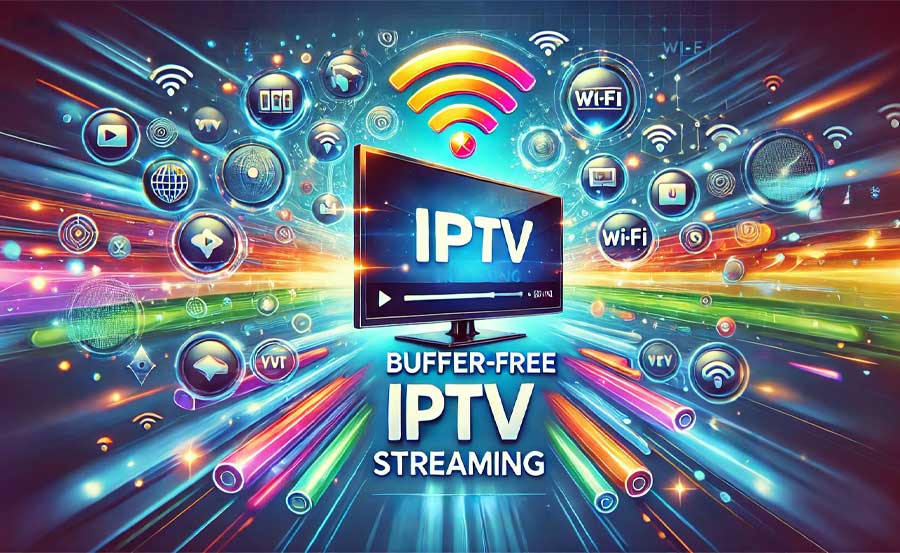Experiencing frequent loading issues with IPTV can disrupt your viewing experience, causing frustration and interrupting your favorite shows. However, with a few smart tweaks and optimization techniques, you can significantly improve IPTV channel performance for seamless, buffer-free streaming. In this guide, we’ll explore the best practices to enhance your IPTV setup and say goodbye to loading delays.
Buy 3 Months IPTV Subscription Now
1. Prioritize a High-Speed and Stable Internet Connection
Your internet connection speed plays a critical role in the quality of your IPTV streaming.
- Recommended Speeds: For SD quality, aim for a minimum of 5 Mbps. For HD, 10 Mbps, and for 4K Ultra HD, 25 Mbps or more is ideal.
- Use Ethernet Over Wi-Fi: A wired connection ensures stability, reducing interference that often comes with Wi-Fi. If you must use Wi-Fi, place your router as close to your device as possible.
2. Optimize Buffer Settings on Your IPTV App
Most IPTV apps allow you to adjust buffer settings, which can be crucial in preventing pauses and buffering issues.
- Increase Buffer Time: In the settings, find the buffer option and increase it slightly to allow the app to load content in advance, reducing the chance of buffering.
- Experiment with Settings: Test different buffer sizes to find the ideal setting for your internet speed.
3. Clear Cache Regularly for Smooth Playback
Over time, cache files can accumulate, slowing down the performance of your IPTV app.
- How to Clear Cache: Go to your device’s settings, find the IPTV app, and select Clear Cache. This will delete unnecessary temporary files, improving streaming speed.
- Regular Maintenance: Clearing cache every few weeks can prevent lag and boost overall app performance.
4. Check Server Quality and Provider Reliability
Not all IPTV providers are equal. Choosing a reputable provider with reliable servers is key to a consistent viewing experience.
- Ask About Server Load: When selecting an IPTV provider, inquire about server stability and performance during peak hours. A quality provider will use high-capacity servers to handle traffic without interruption.
- Opt for a Provider with Multiple Server Options: Some IPTV providers offer server options to switch if one is overloaded, which can drastically improve your viewing experience.
5. Use a High-Quality IPTV Player App
The choice of player app can influence loading speeds and playback quality. Look for apps that are compatible with your IPTV service and optimized for smooth performance.
- Popular IPTV Apps: Consider VLC, TiviMate, or OTT Player, known for stability and enhanced streaming capabilities.
- Regularly Update Your App: Keep your app updated to benefit from performance improvements and bug fixes.Mastering IPTV with Mag Box: A Step-by-Step Guide for Beginners
6. Configure DNS Settings for Faster Data Transmission
Using a DNS server that’s optimized for speed can reduce loading issues.
- How to Change DNS: Access your device’s network settings, and update the DNS settings to Google DNS (8.8.8.8, 8.8.4.4) or Cloudflare DNS (1.1.1.1, 1.0.0.1).
- Benefit: This can potentially improve the connection speed, ensuring quicker access to IPTV servers and faster loading times.
7. Adjust Video Quality to Match Your Connection
Higher video quality demands more bandwidth, which can sometimes cause loading issues if your internet connection isn’t strong enough.
- Adjust to HD or SD: If you’re experiencing buffering, try lowering the video quality to HD or SD. While the resolution might be lower, playback will be much smoother.
- Enable Adaptive Bitrate: Some IPTV apps support adaptive bitrate streaming, which automatically adjusts quality based on your connection speed.
8. Restart Devices and Router Regularly
Simply restarting your device and router can resolve many streaming issues.
- Why Restarting Helps: Power cycling your device clears out active memory and refreshes network connections, which often resolves slow loading.
- Weekly Maintenance: Make it a habit to reboot your streaming device and router at least once a week.
9. Test with a VPN for Throttling Issues
Some ISPs throttle streaming services, which can slow down IPTV. Using a VPN may bypass these restrictions, improving performance.
- Select a High-Speed VPN: Choose a VPN with servers optimized for streaming to avoid additional buffering.
- Check for Compatibility: Not all IPTV providers support VPN usage, so confirm with your provider before enabling it.
10. Consider Upgrading Your Router for Better Connectivity
If you’re still facing issues despite trying all the above methods, upgrading to a modern router can make a significant difference in streaming quality.
- Look for Dual-Band or Tri-Band Routers: These routers offer stronger Wi-Fi performance and are designed to handle multiple devices without reducing speed.
- Set Up a Guest Network: For even more stability, create a guest network solely for streaming, which reduces traffic congestion on the main network.VLC and IPTV: Unlocking Perfect Streaming in Just a Few Steps
Conclusion
By following these optimization tips, you can enjoy a buffer-free IPTV experience, eliminating loading issues and enhancing video quality. With a stable internet connection, the right app settings, a reliable IPTV provider, and occasional maintenance, you’ll achieve smoother, uninterrupted streaming on all your favorite IPTV channels. Say goodbye to loading delays and hello to endless, high-quality entertainment!


